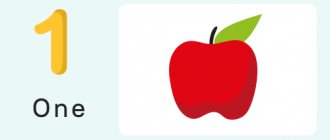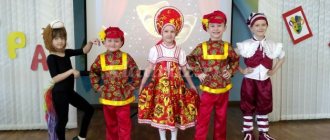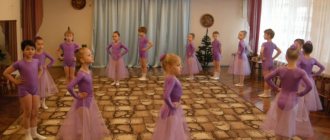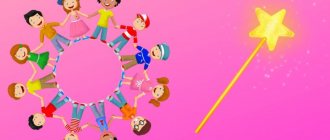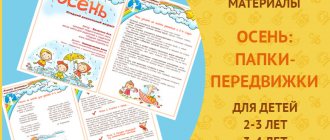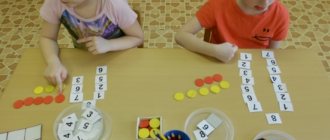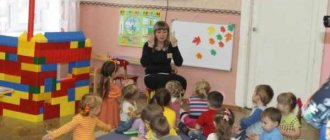Card index “Physical education in the second junior group”
Abdulova Dzhume Sirazhutdinovna
Card index “Physical education in the second junior group”
Lesson 1
Tasks. Practice walking between objects, running in all directions; in maintaining stable balance when walking on increased support; in jumping.
Part 1. Walking in a column one at a time; walking between objects (cubes, skittles placed along the hall; the distance between them is 1 m. Children in a column, one at a time, walk between objects in a “snake” manner. When the last child in the column passes between the objects, the command is given to run in all directions. The task is repeated twice.
Part 2. General developmental exercises with a hoop.
1. I. p. – feet at the width of the foot, hoop with a grip from the sides, below. Raise the hoop up, look out the “window”, lower the hoop down, return to the starting position (5 times).
2. I. p. – standing with feet hip-width apart, hoop in bent arms near the chest, grip of arms from the sides. Sit down, bring the hoop forward, rise, return to the starting position (4 times).
3. I. p. - feet shoulder-width apart, hoop in bent arms near the chest. Raise the hoop up, lean to the right (left); straighten up, return to the starting position (2-3 times).
4. I. p. - standing in a hoop, legs slightly apart, hands on the belt. Jumping on two legs in a hoop, alternating with a short pause.
Main types of movements.
Equilibrium. Walking on the board sideways with an extended step, hands on the belt, at a moderate pace. At the end of the bench, step down and step forward. The teacher provides assistance and insurance (2-3 times).
Jumping from bump to bump. Along the opposite sides of the hall there are 5-6 hoops at a distance of 50 cm from one another in a checkerboard pattern. After the teacher shows and explains the task, the children line up in two columns and perform jumps from hoop to hoop in a continuous manner. The teacher makes sure that the children push off energetically from the floor and land on bent legs, maintaining the required distance.
Outdoor game "Hen and Chicks".
3rd part. Game "Let's find the chicken."
Lesson 2
Tasks. Exercise walking with stepping, developing coordination of movements; repeat tasks in jumping and throwing a ball.
Part 1. Walk in a column one at a time, stepping over the cords with your right and left feet alternately. The cords are placed at a distance of 30–35 cm from one another (child’s step). The main thing is that there are no extra steps. Then the command is given to run in all directions, using the entire area of the hall.
Part 2. General developmental exercises.
1. I. p. - legs at the width of the foot, arms along the body. Raise your arms up to your sides, clap your hands above your head; lower your arms, return to the starting position (9 times).
2. I. p. - feet width apart, hands behind the back. Sit down, clap your hands in front of you; straighten up, return to the starting position (4 times).
3. I. p. – feet shoulder-width apart, arms to the sides. Tilt to the right, touch your right leg with your palm, straighten up, arms to the sides. The same to the left (4–5 times).
4. I. p. - feet shoulder-width apart, hands on the belt. Turn to the right, arms to the sides; return to the starting position. The same to the left (3 times).
5. I. p. – legs slightly apart, arms at random. Jump on two legs with a turn to the right, return to the starting position. The same to the left (3-4 times).
Main types of movements.
Jumping "Across the Ditch" In the hall, on both sides of the cords there are 4–5 “grooves” (30 cm wide), one parallel to the other. Children in two columns perform jumps on two legs from “groove to groove”: waving their arms, they energetically push off from the floor and land on half-bent legs.
The exercise is repeated 2-3 times.
Funny Ball Throwing. After performing the jumps, the children take one ball from the box (basket). The children stand in a semicircle, or in two ranks, or randomly throughout the hall. The teacher shows and explains the exercise: “Feet shoulder-width apart, ball in bent arms near the chest. You need to throw the ball at the toes, catch it with both hands after bouncing off the floor, trying not to press it to your chest.” Children take their starting position and throw balls at a signal. After all the children have caught the balls, the signal is given for the next throw. The exercise is repeated 8-10 times.
Outdoor game “Birds in nests”.
3rd part. Walking in a column one at a time.
Lesson 3
Tasks. Practice walking and running in a circle, turning at a signal; repeat rolling balls, developing dexterity and eye; crawling in a straight line.
Part 1. Walking and running around the cubes with a turn in the other direction at the teacher’s signal (cubes according to the number of children). After walking and running exercises, the teacher invites each child to take a cube. Formation in a circle.
Part 2. General developmental exercises with a cube.
1. I. p. – legs at the width of the foot, cube in the right hand below. Raise your arms up through your sides, transfer the cube to your left hand, lower your hand. The same with the left hand (3-4 times).
2. I. p. – feet shoulder-width apart, cube behind back in right hand. Bend over, put the cube on the floor, straighten up; bend over, take the cube in your left hand, straighten up. And so on alternately (4 times).
3. I. p. - sitting, legs crossed, cube in right hand. Turn to the right, place the cube at the toes; straighten up, hands on your waist. Turn to the right, take the cube, transfer it to your left hand. The same to the left (3 times).
4. I. p. – legs slightly apart, arms at random, cube on the floor. Jumping on two legs around the cube in both directions (2-3 times).
Main types of movements.
“Ride between objects.” Rolling balls between medicine balls (4-5 pieces, lying at a distance of 1 m from each other. The ball moves like a “snake” between objects - children push it with two hands folded in a “boat”. At the end of the exercise, you need to take the ball in your hands and lift it over your head and stretch.
Crawling in the forward direction “Funny Bugs”. Crawling on a gymnastic bench on your hands and knees - fast, like bugs. It is performed in-line in two columns (2–3 times).
Outdoor game "Frogs".
3rd part. Walking in a column one at a time.
Lesson 4
Game exercises on the covered and mastered material.
1. "Beetles." At the teacher’s signal: “The beetles have flown!” - the children scatter all over the hall. At the signal: “The beetles are resting,” the children lie on their backs and move their legs and arms, as if moving their paws. Then the “bugs” fly again and rest (you can use musical accompaniment).
2. "Ride - catch." Children are divided into threes and take their starting position - sitting, legs apart. In the hands of one of the players is a ball of large diameter. At the signal: “Let’s go!” – children take turns rolling the ball to each other.
3. Outdoor game “Find your color.”
Plans and outlines of physical education classes for pupils of the first junior group
| Final part | ||
| Low-intensity outdoor game “Find where it’s hidden”: the players close their eyes, and the teacher hides a small object on the playground. At a signal, children open their eyes, calmly walk around the playground and look for an object. The one who found it picks it up, the game repeats again | 2 times | The teacher tells the children what exactly he hid (toy, ball, cube). You can't run during the game |
Outline No. 3
Transport
Location:
outdoor playground or gym.
Form:
integrated (with the educational area “Child and Society”).
Tasks:
Increase the functional stability of the vestibular apparatus;
To form an idea of transport in the immediate environment and its types; teach walking on a gymnastic bench and jumping from a height;
Stimulate and maintain interest in transport.
Equipment:
chairs according to the number of children, 5–6 large gymnastic sticks, 2 cords, gymnastic bench, mat, pictures of transport (bus, plane, train)
| Content | Dosage | Organizational and methodological instructions |
| Introductory part | ||
| Types of transport 1. The teacher sequentially shows the children pictures of a bus, plane, train and clarifies how it can be called in one word (transport). Children use pictures to determine what the vehicle has in common (wheels, steering wheel, motor). The teacher invites children to go on a trip using different types of transport | 4 min | |
| We're going by bus 2. Outdoor game “Bus”: in the center of the hall there is a bus built from chairs. It has a seat for the driver (the first chair) and a lounge for passengers (all other chairs, arranged in twos). The teacher sits in the driver's seat, and the children take the passenger chairs and remember their place. At stops, passengers get off the bus and perform variations of walking (on their toes, in a squat), and then take their seats again in the cabin | 2–3 times | The bus rides to the music, the driver holds a hoop in his hands - the “steering wheel” After stops, passengers take only their seats. To improve orientation in space, you can use chairs of different colors or mark identical chairs with colored stickers. At the end of the game, the bus arrives at the airport and the teacher invites the children to travel further by plane |
| We're flying by plane 3. Outdoor game “Planes”, the players – “planes” – sit on “airfields” – chairs. At the command “Planes start engines!” children make circular movements with their arms bent in front of their chest and pronounce the sound | 3 times | Chairs are arranged around the site in random order You only need to land at your airfield |

